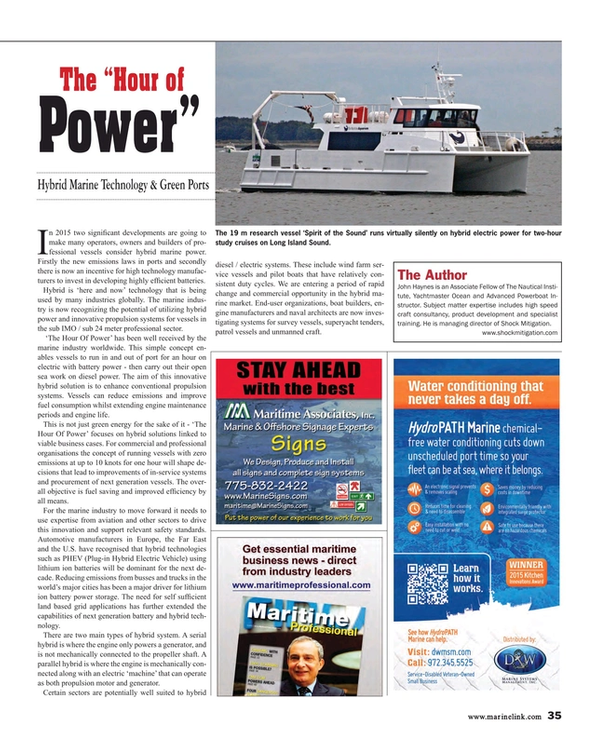
The 'Hour of Power': Hybrid Marine Technology & Green Ports
In 2015 two significant developments are going to make many operators, owners and builders of professional vessels consider hybrid marine power. Firstly the new emissions laws in ports and secondly there is now an incentive for high technology manufacturers to invest in developing highly efficient batteries.
Hybrid is ‘here and now’ technology that is being used by many industries globally. The marine industry is now recognizing the potential of utilizing hybrid power and innovative propulsion systems for vessels in the sub IMO / sub 24 meter professional sector.
‘The Hour Of Power’ has been well received by the marine industry worldwide. This simple concept enables vessels to run in and out of port for an hour on electric with battery power - then carry out their open sea work on diesel power. The aim of this innovative hybrid solution is to enhance conventional propulsion systems. Vessels can reduce emissions and improve fuel consumption whilst extending engine maintenance periods and engine life.
This is not just green energy for the sake of it - ‘The Hour Of Power’ focuses on hybrid solutions linked to viable business cases. For commercial and professional organisations the concept of running vessels with zero emissions at up to 10 knots for one hour will shape decisions that lead to improvements of in-service systems and procurement of next generation vessels. The overall objective is fuel saving and improved efficiency by all means.
For the marine industry to move forward it needs to use expertise from aviation and other sectors to drive this innovation and support relevant safety standards. Automotive manufacturers in Europe, the Far East and the U.S. have recognised that hybrid technologies such as PHEV (Plug-in Hybrid Electric Vehicle) using lithium ion batteries will be dominant for the next decade. Reducing emissions from busses and trucks in the world’s major cities has been a major driver for lithium ion battery power storage. The need for self sufficient land based grid applications has further extended the capabilities of next generation battery and hybrid technology.
There are two main types of hybrid system. A serial hybrid is where the engine only powers a generator, and is not mechanically connected to the propeller shaft. A parallel hybrid is where the engine is mechanically connected along with an electric ‘machine’ that can operate as both propulsion motor and generator.
Certain sectors are potentially well suited to hybrid diesel / electric systems. These include wind farm service vessels and pilot boats that have relatively consistent duty cycles. We are entering a period of rapid change and commercial opportunity in the hybrid marine market. End-user organizations, boat builders, engine manufacturers and naval architects are now investigating systems for survey vessels, superyacht tenders, patrol vessels and unmanned craft.
The Author
John Haynes is an Associate Fellow of The Nautical Institute, Yachtmaster Ocean and Advanced Powerboat Instructor. Subject matter expertise includes high speed craft consultancy, product development and specialist training. He is managing director of Shock Mitigation.
www.shockmitigation.com
(As published in the July 2015 edition of Maritime Reporter & Engineering News - http://magazines.marinelink.com/Magazines/MaritimeReporter)
Read The 'Hour of Power': Hybrid Marine Technology & Green Ports in Pdf, Flash or Html5 edition of July 2015 Maritime Reporter
Other stories from July 2015 issue
Content
- DNV GL: ‘Big Data’ Evolving Fast; LNG Slower than Expected page: 10
- Fuel Efficiency: The Way Forward page: 12
- Preventing Loss of Propulsion After Fuel Switch to Low Sulfur Distillate Fuel page: 14
- How to Defend against Patent Trolls without Breaking the Bank page: 16
- Shore Leave: Re-think on Balancing Security, Seafarer Rights page: 18
- “FS3” Motion-based Simulator for Dutch Navy page: 20
- Big Data: Big Value or Big Risk? page: 21
- Björn Rosengren: Power Boss (Part II) page: 22
- The Maritime Launch of Big Data page: 26
- Building Out on Big Data page: 30
- Maritime & Shipbuilding Italian Style page: 32
- Two-Stroke DF Engine Passes Critical Test page: 34
- The 'Hour of Power': Hybrid Marine Technology & Green Ports page: 35
- Specialty Motors Keep Shipping Afloat page: 36
- HYPACK Barge Management System page: 37
- Simrad Launches New Pro Line Products page: 38
- Pneumatic Band Saw page: 40
- Portable Hydraulic Drills page: 40
- Verotec’s VMEbus Systems page: 40
- Silvagrip page: 40
- Protea Heavy Lift Cranes page: 40
- Senesco Invests in New Welding System page: 40
- PYPLOK: An Alternative to Welding page: 40
- Ballast Water Compliance Tools page: 41
- Tero Marine Wins Boa Contract page: 41
- MarineNav Rack Mount Computers Range page: 41
- New Transas Pilot PRO page: 41
- Coxreels Debuts New Reel Design with 1600 Series page: 41
- Lowrance Announces Software Updates page: 41
- Almarin: 85 Years Strong page: 47


